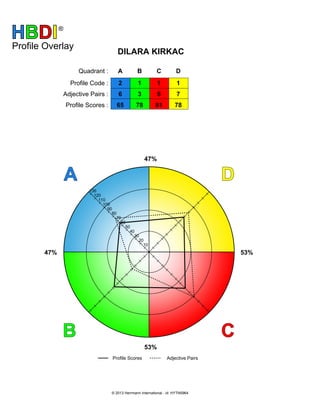KIRKAC
- 1. HBDI®
Profile Overlay
DILARA KIRKAC
Quadrant : A B C D
Profile Code : 2 1 1 1
Adjective Pairs : 6 3 8 7
Profile Scores : 65 78 81 78
47% 53%
47%
53%
Profile Scores Adjective Pairs
© 2013 Herrmann International - id: HYTN5964
10
20
30
40
50
60
70
80
90
100
110
120
130
A
B
D
C
- 2. HERRMANN BRAIN DOMINANCE INSTRUMENT
DATA SUMMARY
id: HYTN5964
NAME DILARA KIRKAC GENDER F GROUP 144800
OCCUPATION Student DATE 10 23 2013
COLUMN A
UPPER LEFT
COLUMN B
LOWER LEFT
COLUMN C
LOWER RIGHT
COLUMN D
UPPER RIGHT
65
2
78
1
81
1
78
1
6 3 8 7
analytical
logical X
mathematical
rational X
critical X
quantitative
factual
reader
speaker X
dominant *
detailed
sequential
controlled
conservative
reader
talker X
intuitive
symbolic
spiritual
musical X
emotional X
spatial
simultaneous
synthesizer
holistic
intuitive
artistic
imaginative X
financial 3
problem solving 3
technical 2
analytical 4
implementation 4
administrative 5
planning 3
organization 2
interpersonal 5
expressing 4
writing 4
teaching 1
innovating 5
creative 5
conceptualizing 3
integration 1
primarily right some left
right
X
mixed some right
left
primarily left
day equal
X
night
none some
X
frequent
introverted extroverted
X
PROFILE SCORES
PREFERENCE CODE
ADJECTIVE PAIRS
KEY DESCRIPTORS
(*MOST DESCRIPTIVE)
WORK ELEMENTS
ADOLESCENT EDUCATION
EDUCATIONAL FOCUS
OCCUPATION
HOBBIES
HAND DOMINANCE
ENERGY LEVEL
MOTION SICKNESS
INTROVERT/EXTROVERT
© 2013 Herrmann International
- 3. © 2013 Herrmann International
DILARA KIRKAC - An explanation of your HBDI® Profile.
Date : 24 10 13 - Page 1/1
Your HBDI® Profile Sheet provides you with a visual plot of your thinking style preferences.
The Data Summary Sheet gives a breakdown of what quadrant many of the questions fall into.
This explanation page will describe each of the quadrants in descending order of your preference :
C > D > B > A
The thinking style quadrant you most prefer, based upon your responses to the HBDI® Survey, is the C Quadrant, with
a value of 81.
Descriptors in this thinking style which you selected are Musical, Talker and Emotional. These descriptors represent a
general overview of your mental preferences in day-to-day life.
Work Elements you strongly relate to in this quadrant include Writing, Expressing and Interpersonal. These Elements
reflect your mental preferences at work. Work preferences may align completely with general preferences, or they may
stem from situations unique to one's working environment.
In the forced-choice, Adjective Pairs section of the Survey, 33% of your responses registered in the C Quadrant. For
comparison purposes, your C Quadrant Profile Score represents 27% of your total Profile.
By only a slight margin, your next most preferred is the D Quadrant, with 78 points. In this thinking style, you selected
Imaginative as descriptive of you. Work Elements you identified as ones you do well include Creative and Innovating.
In Adjective Pairs 29% of your responses registered in the D Quadrant, compared to 26% of your overall Profile.
In the B Quadrant you also produced a cumulative value of 78, suggesting an equal preference for this style of thinking.
In this quadrant you selected Speaker, with Dominant representing your 'Key Descriptor' - the one most descriptive of
you. Work Elements you identified as ones you do well include Administrative and Implementation. 13% of your
Adjective Pairs responses fell in the B Quadrant, compared to 26% of your Profile.
Your least preferred quadrant, based upon your Survey responses, is the A Quadrant, with a value of 65. In this
quadrant you selected Logical, Critical and Rational as characteristic of you. 25% of your Adjective Pairs responses fell
in the A Quadrant, compared to 22% of your Profile.
The Adjective Pairs result tells us something about how we react when under pressure. This may or may not be
consistent with our general behaviour. The distribution of your responses to these questions into the A, B, C and D
Quadrants was 6 - 3 - 8 - 7 respectively. This distribution is noticeably different from your profile (as you may have
noticed in the percentage comparisons above). This is neither a good nor bad quality, but it suggests that you may
respond quite differently when under pressure than at other times. Some people with this characteristic also find that
people see them more like the Adjective Pair distribution than the Profile.
